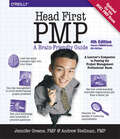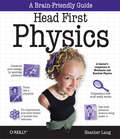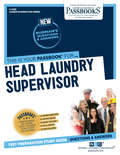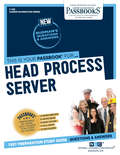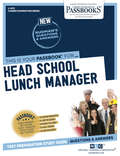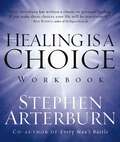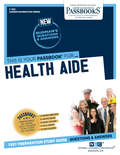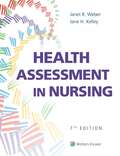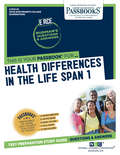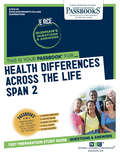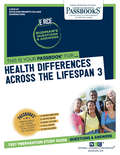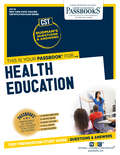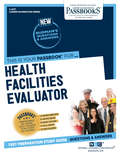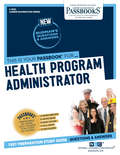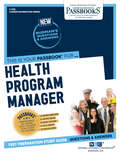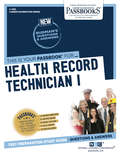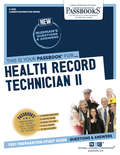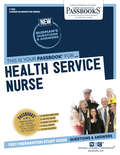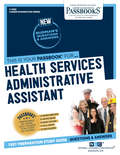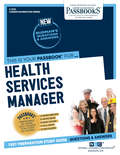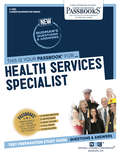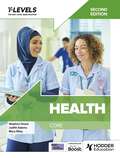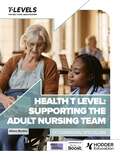- Table View
- List View
Head First PMP: A Learner's Companion to Passing the Project Management Professional Exam (Head First Ser.)
by Jennifer Greene Andrew StellmanNow updated for the 2021 PMP Exam What will you learn from this book?Head First PMP teaches you the latest principles and certification objectives in The PMBOK® Guide in a unique and inspiring way. This updated fourth edition takes you beyond specific questions and answers with a unique visual format that helps you grasp the big picture of project management. By putting PMP concepts into context, you'll be able to understand, remember, and apply them--not just on the exam, but on the job. No wonder so many people have used Head First PMP as their sole source for passing the PMP exam.This book will help you:Learn PMP's underlying concepts to help you understand the PMBOK principles and pass the certification exam with flying colorsGet 100% coverage of the latest principles and certification objectives in The PMBOK® Guide, Sixth EditionMake use of a thorough and effective preparation guide with hundreds of practice questions and exam strategiesExplore the material through puzzles, games, problems, and exercises that make learning easy and entertainingWhy does this book look so different?Based on the latest research in cognitive science and learning theory, Head First PMP uses a visually rich format to engage your mind, rather than a text-heavy approach that puts you to sleep. Why waste your time struggling with new concepts? This multi-sensory learning experience is designed for the way your brain really works.
Head First Physics: A learner's companion to mechanics and practical physics (AP Physics B - Advanced Placement) (Head First)
by Heather LangWouldn't it be great if there were a physics book that showed you how things work instead of telling you how? Finally, with Head First Physics, there is. This comprehensive book takes the stress out of learning mechanics and practical physics by providing a fun and engaging experience, especially for students who "just don't get it."Head First Physics offers a format that's rich in visuals and full of activities, including pictures, illustrations, puzzles, stories, and quizzes -- a mixed-media style proven to stimulate learning and retention. One look will convince you: This isn't mere theory, this is physics brought to life through real-world scenarios, simple experiments, and hypothetical projects. Head First Physics is perfect for anyone who's intrigued by how things work in the natural world.You'll quickly discover that physics isn't a dry subject. It's all about the world we live in, encompassing everything from falling objects and speeding cars, to conservation of energy and gravity and weightlessness, and orbital behavior. This book:Helps you think like a physicist so you can understand why things really work the way they doGives you relevant examples so you can fully grasp the principles before moving on to more complex conceptsDesigned to be used as a supplement study guide for the College Board's Advanced Placement Physics B ExamIntroduces principles for the purpose of solving real-world problems, not memorizationTeaches you how to measure, observe, calculate -- and yes -- how to do the mathCovers scientific notation, SI units, vectors, motion, momentum conservation, Newton's Laws, energy conservation, weight and mass, gravitation and orbits, circular motion and simple harmonic motion, and much moreIf "Myth Busters" and other TV programs make you curious about our physical world -- or if you're a student forced to take a physics course -- now you can pursue the subject without the dread of boredom or the fear that it will be over your head. Head First Physics comes to rescue with an innovative, engaging, and inspirational way to learn physics!
Head Laundry Supervisor: Passbooks Study Guide (Career Examination Series)
by National Learning CorporationThe Head Laundry Supervisor Passbook® prepares you for your test by allowing you to take practice exams in the subjects you need to study. It provides hundreds of questions and answers in the areas that will likely be covered on your upcoming exam, including but not limited to; Operation of power laundries, including materials, supplies, proper processing of certain materials, and the operation and preventative maintenance of powered laundry equipment; Keeping simple inventory records; Work scheduling; Supervision; and more.
Head Process Server: Passbooks Study Guide (Career Examination Series #C-349)
by National Learning CorporationThe Head Process Server Passbook® prepares you for your test by allowing you to take practice exams in the subjects you need to study. It provides hundreds of questions and answers in the areas that will likely be covered on your upcoming exam.
Head School Lunch Manager: Passbooks Study Guide (Career Examination Series)
by National Learning CorporationThe Head School Lunch Manager Passbook® prepares you for your test by allowing you to take practice exams in the subjects you need to study. It provides hundreds of questions and answers in the areas that will likely be covered on your upcoming exam, including but not limited to: principles and techniques of supervision and management; foods, including nutrition and food requirements; menu planning and food storage; food production, preparation and service; mathematics required for accounting for cash receipts and purchase funds and other related areas.
Healing is a Choice Workbook: 10 Decisions That Will Transform Your Life and the 10 Lies That Can Prevent You From Making Them
by Stephen ArterburnIt is God's choice to heal, when to heal, and how healing will occur. Sadly we often make choices that prevent God's healing or interfere with His timing. Millions suffer from emotional, spiritual, and even physical wounds that God may choose to heal. Ten common lies prevent individuals from making those choices that bring about healing. Jesus once asked a man who had been sick for 38 years if he wanted to be healed. This workbook asks the reader the same question and enhances understanding by providing 10 choices to make on the path toward healing. This study is based on the promise of Psalm 147:3, "He heals the broken-hearted, binding up their wounds. Engage in the process of healing. Experience emotional, spiritual, and sometimes physical healing. Transform brokenness into new life mission. Identify the big lies that prevent experiencing emotional, spiritual, and even physical healing.
Health Aide: Passbooks Study Guide (Career Examination Series #C-1372)
by National Learning CorporationThe Health Aide Passbook® prepares you for your test by allowing you to take practice exams in the subjects you need to study. It provides hundreds of questions and answers in the areas that will likely be covered on your upcoming exam.
Health Assessment in Nursing
by Janet R. Weber Jane H. KelleyPraised for its colorful, visually engaging approach to assessment, Health Assessment in Nursing, 7th Edition makes assessment concepts easy to understand and helps students cultivate the knowledge and skills to confidently perform effective health assessments in a variety of healthcare settings. This updated 7th Edition reflects the latest trends and topical issues in nursing practice and incorporates a suite of powerful learning tools to strengthen students’ critical thinking capabilities and ensure effective data analysis and problem detection for nursing clients.
Health Differences Across the Life Span 1: Passbooks Study Guide (Excelsior/Regents College Examination Series)
by National Learning CorporationThe Excelsior/Regents College Examinations (E/RCE) offer you an opportunity to obtain recognition for college-level learning and consists of exams designed to demonstrate achievement and mastery of various college-level subjects, such as the Arts and Sciences, Business, Criminal Justice, Education, Health and Nursing. The E/RCE Health Differences Across the Life Span 1 Passbook® prepares you by sharpening knowledge of the skills and concepts necessary to succeed on the upcoming exam and the college courses that follow. It provides a series of informational texts as well as hundreds of questions and answers in the areas that will likely be covered on your upcoming exam.
Health Differences Across the Life Span 2: Passbooks Study Guide (Excelsior/Regents College Examination Series)
by National Learning CorporationThe Excelsior/Regents College Examinations (E/RCE) offer you an opportunity to obtain recognition for college-level learning and consists of exams designed to demonstrate achievement and mastery of various college-level subjects, such as the Arts and Sciences, Business, Criminal Justice, Education, Health and Nursing. The E/RCE Health Differences Across the Life Span 2 Passbook® prepares you by sharpening knowledge of the skills and concepts necessary to succeed on the upcoming exam and the college courses that follow. It provides a series of informational texts as well as hundreds of questions and answers in the areas that will likely be covered on your upcoming exam.
Health Differences Across the Life Span 3: Passbooks Study Guide (Excelsior/Regents College Examination Series)
by National Learning CorporationThe Excelsior/Regents College Examinations (E/RCE) offer you an opportunity to obtain recognition for college-level learning and consists of exams designed to demonstrate achievement and mastery of various college-level subjects, such as the Arts and Sciences, Business, Criminal Justice, Education, Health and Nursing. The E/RCE Health Differences Across the Life Span 3 Passbook® prepares you by sharpening knowledge of the skills and concepts necessary to succeed on the upcoming exam and the college courses that follow. It provides a series of informational texts as well as hundreds of questions and answers in the areas that will likely be covered on your upcoming exam.
Health Education: Passbooks Study Guide (New York State Teacher Certification Examination Series (NYSTCE) #T-24)
by National Learning CorporationThe New York State Teacher Certification Exams (NYSTCE) are required for all candidates seeking licensure in the State. The NYSTCE series consists of many different tests assessing skills and abilities necessary for teachers. The Passbook® for the Content Specialty Test in Health Education provides hundreds of multiple-choice questions in the areas that will likely be covered on your upcoming certification exam, including but not limited to: human growth and development; nutrition; physical fitness; effects of drugs, alcohol and tobacco; and other related areas.
Health Facilities Evaluator: Passbooks Study Guide (Career Examination Series)
by National Learning CorporationThe Health Facilities Evaluator Passbook® prepares you for your test by allowing you to take practice exams in the subjects you need to study. It provides hundreds of questions and answers in the areas that will likely be covered on your upcoming exam, including but not limited to: written communication; health facility operations; writing skills; reading comprehension; analytical skills; and more.
Health Program Administrator: Passbooks Study Guide (Career Examination Series #C-3601)
by National Learning CorporationThe Health Program Administrator Passbook® prepares you for your test by allowing you to take practice exams in the subjects you need to study. It provides hundreds of questions and answers in the areas that will likely be covered on your upcoming exam, including but not limited to: administration; educating and interacting with the public; planning, staffing and managing a program; supervision; preparing written material; and other related areas.
Health Program Manager: Passbooks Study Guide (Career Examination Series)
by National Learning CorporationThe Health Program Manager Passbook® prepares you for your test by allowing you to take practice exams in the subjects you need to study. It provides hundreds of questions and answers in the areas that will likely be covered on your upcoming exam, including but not limited to: state and federal laws and regulations; preparing reports; health care programs and trends; management and public administration; supervision; verbal and written communication; and more.
Health Record Technician I: Passbooks Study Guide (Career Examination Series)
by National Learning CorporationThe Health Record Technician I Passbook® prepares you for your test by allowing you to take practice exams in the subjects you need to study. It provides hundreds of questions and answers in the areas that will likely be covered on your upcoming exam, including but not limited to: basic medical terminology, human terminology and human anatomy; health record systems and methodology used by health facilities; classification of morbidity and mortality information; meet and deal tactfully with the public; and other related areas.
Health Record Technician II: Passbooks Study Guide (Career Examination Series)
by National Learning CorporationThe Health Record Technician II Passbook® prepares you for your test by allowing you to take practice exams in the subjects you need to study. It provides hundreds of questions and answers in the areas that will likely be covered on your upcoming exam, including but not limited to: basic medical terminology, human terminology and human anatomy; health record systems and methodology used by health facilities; classification of morbidity and mortality information; meet and deal tactfully with the public; and other related areas.
Health Service Nurse: Passbooks Study Guide (Career Examination Series)
by National Learning CorporationThe Health Service Nurse Passbook® prepares you for your test by allowing you to take practice exams in the subjects you need to study. It provides hundreds of questions and answers in the areas that will likely be covered on your upcoming exam, including but not limited to: provide skilled nursing and follow-up care for both occupational and non-occupational illnesses and injuries; counsel employees on health and related problems; establish and maintain cooperative relationships with community health organizations and physicians; maintain helath records, supplies and equipment; observe and record results of various phases of examinations and testing; and other related areas.
Health Services Administrative Assistant: Passbooks Study Guide (Career Examination Series)
by National Learning CorporationThe Health Services Administrative Assistant Passbook® prepares you for your test by allowing you to take practice exams in the subjects you need to study. It provides hundreds of questions and answers in the areas that will likely be covered on your upcoming exam, including but not limited to: basic medical procedures; medical terminology; understanding and interpreting written material; and more.
Health Services Manager: Passbooks Study Guide (Career Examination Series)
by National Learning CorporationThe Health Services Manager Passbook® prepares you for your test by allowing you to take practice exams in the subjects you need to study. It provides hundreds of questions and answers in the areas that will likely be covered on your upcoming exam, including but not limited to; Public health; Mental Hygiene; Management and administration principles and techniques; Fiscal and financial matters; Supervision and training principles and techniques; and more.
Health Services Specialist: Passbooks Study Guide (Career Examination Series)
by National Learning CorporationThe Health Services Specialist Passbook® prepares you for your test by allowing you to take practice exams in the subjects you need to study. It provides hundreds of questions and answers in the areas that will likely be covered on your upcoming exam, including but not limited to: professional nursing principles and practices; working effectively in a multidisciplinary clinical staff; performing evaluations and preparing reports; verbal and written communication; and more.
Health T Level: Core Second Edition
by Mary Riley Judith Adams Stephen HoareBegin your path to a career in Health with our second edition T Level textbook that covers the core content you will need to understand to be successful in your qualification. Develop your knowledge and understanding of the key principles, concepts, theories, and skills that will give you a solid foundation to support you during your industry placement.Created in partnership with NCFE and written by highly respected authors Judith Adams, Stephen Hoare and Mary Riley, feel confident knowing you can rely on the insights and experience these experts.- Stay on track throughout the course, using the learning outcomes at the beginning of every unit and the 'Test yourself' questions throughout. - Improve your understanding of important terminology with a 'Key Terms' feature, as well as a detailed glossary.- Develop a deeper understanding of each topic with case studies, reflection tasks and practice points, which contextualise the content within the healthcare industry.- Reinforce professional skills with helpful tips and guidelines for good practice.- Feel confident going into the exams with opportunities to consolidate and test your learning with lots of practice questions.- Prepare for assignments with practical tasks and model answers, with relevant knowledge that will be useful to know highlighted throughout.For the September 2023, Version 3.0 specification.
Health T Level: Core Second Edition
by Mary Riley Judith Adams Stephen HoareBegin your path to a career in Health with our second edition T Level textbook that covers the core content you will need to understand to be successful in your qualification. Develop your knowledge and understanding of the key principles, concepts, theories, and skills that will give you a solid foundation to support you during your industry placement.Created in partnership with NCFE and written by highly respected authors Judith Adams, Stephen Hoare and Mary Riley, feel confident knowing you can rely on the insights and experience these experts.- Stay on track throughout the course, using the learning outcomes at the beginning of every unit and the 'Test yourself' questions throughout. - Improve your understanding of important terminology with a 'Key Terms' feature, as well as a detailed glossary.- Develop a deeper understanding of each topic with case studies, reflection tasks and practice points, which contextualise the content within the healthcare industry.- Reinforce professional skills with helpful tips and guidelines for good practice.- Feel confident going into the exams with opportunities to consolidate and test your learning with lots of practice questions.- Prepare for assignments with practical tasks and model answers, with relevant knowledge that will be useful to know highlighted throughout.For the September 2023, Version 3.0 specification.
Health T Level: Occupational Specialism
by Alison BurtonBegin your path to a career in Adult Nursing with the only textbook available for the Health T Level occupational specialism, created in partnership with NCFE.Covering all the units for the Adult Nursing specialism, this accessible and engaging textbook will equip you with a confident understanding of the knowledge and skills you need to be successful in this qualification.- Track and strengthen your knowledge using learning outcomes at the beginning of every unit and Test Yourself questions throughout- Improve your understanding of important terminology and key terms, plus contextualise your learning with case studies and reflection tasks- Prepare for your placement with tips on best practice and health and safety in the workplace, alongside 'what if' scenarios to place your learning into real-life contexts- Support the final assignments with practical activities, and use our assessment practice to develop your understanding and build confidence- Trust in our author's experience, with over 20 years of teaching and industry expertise
Health T Level: Occupational Specialism
by Alison BurtonBegin your path to a career in Adult Nursing with the only textbook available for the Health T Level occupational specialism, created in partnership with NCFE.Covering all the units for the Adult Nursing specialism, this accessible and engaging textbook will equip you with a confident understanding of the knowledge and skills you need to be successful in this qualification.- Track and strengthen your knowledge using learning outcomes at the beginning of every unit and Test Yourself questions throughout- Improve your understanding of important terminology and key terms, plus contextualise your learning with case studies and reflection tasks- Prepare for your placement with tips on best practice and health and safety in the workplace, alongside 'what if' scenarios to place your learning into real-life contexts- Support the final assignments with practical activities, and use our assessment practice to develop your understanding and build confidence- Trust in our author's experience, with over 20 years of teaching and industry expertise
